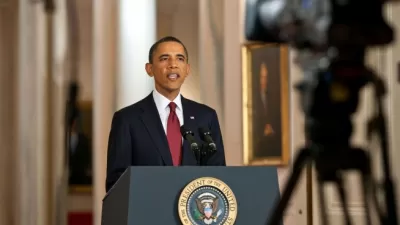Infrastructure
Iskandar Malaysia: The Future of Urban Living or Pipe Dream?
Across the strait from Singapore, Iskandar Malaysia is being planned as the world’s next eco mega-city. Its architects and developers hope it will offer an alternative to Asia's polluted cities and a glimpse of the future of urban living.
Should New York Build Sea Barriers?
As NYC struggles to cope with the damage from Superstorm Sandy, officials and experts are revisiting the possibility of building, at great cost, a protective barrier around its coast.
Gasoline Rationing Spreads to NYC, Long Island
With only 25% of gas stations in NYC operating, the mayor has instituted odd-even rationing that has proven effective in reducing lines in NJ. Meanwhile, MTA announced most transit and subway service have been restored to pre-Hurricane Sandy levels.
How Spain’s Building Bust Can Inform the Future of Urbanization
"The City That Never Was" is the title of an upcoming symposium, and series of essays, organized by the Architectural League of NY to explore two decades of growth and decline in Spain through the prism of unrealized architectural ambitions.
Oberstar's Revenge
Former Rep. Jim Oberstar (D-MN) and chair of the House Transportation Committee was ousted by Chip Cravaack (R) in 2010, who took his seat on the committee and proceeded to gut Oberstar's goals. Cravaack was ousted by Rick Nolan (D), on Nov. 6.
Sandy Provides Opportunity for NYC to Lead on Climate Adaptation
As an increasing percentage of the world's population, and economic assets, confront the threats of climate change, the aftermath of Sandy provides an opportunity for New York to set a global example for building stronger, smarter cities.
Building Small is the Next Big Thing
A recent study documents the shift from large-scale units of production to smaller mass-produced units that can be dispersed across many locations. This shift promises to change a host of industries, from transportation to power generation.

Proposals for Obama's Second Term
No sooner had the ink dried on the Times' "Obama's Night" headline, than planning advocates began offering suggestions for what the President should focus on in his second term. With an enduring split in Congress it's unclear what is achievable.
What Happens When You Build It, But They Never Come?
Forty-five miles southwest of the Twin Cities sits the exurb of New Prague, a town with state-of-the-art infrastructure but crushing debt. It’s an example of what happens when the “Ponzi scheme” underlying sprawl development comes crumbling down.
Toronto: Pay Attention to the Pedestrians
The intersection of Yonge and Harbour is just one example of the dangerous conditions that confront Toronto’s pedestrians daily. Are the police to blame for the city’s lack of pedestrian safety?

Is it Time to Let New Jersey's Beaches Go Natural?
For decades, New Jersey's coastal communities have been the beneficiaries of artificial beach nourishment, at great expense. After Sandy washed away hundreds of million of dollars of sand, some are suggesting it's time for a strategic retreat.
A Ride on the Rails Reveals America's Changing Economy
Adam Davidson reflects on the urban decay that can be glimpsed out the window of an Amtrak train traveling between New York and Washington D.C., and the forces transforming the nation's economy that cannot.
Why New York Must Learn to Stop Worrying and Love the Water
Justin Davidson argues that New York's ability to adapt to the effects of climate change will rely on the city learning to embrace nature rather than vainly trying to fight it.
Low-Cost Solutions Can Bolster Climate Resilience
As we've heard recently, many of the places most vulnerable to rising sea levels and extreme weather are in developing countries. Encouragingly, however, Sandy revealed several low-cost solutions to help mitigate the impacts of severe storms.
At Least One Group Welcomes Sandy’s Healing Power
The construction industry is licking its chops as plans for Sandy’s recovery take shape. After years of idleness due to the housing bust, builders and contractors find themselves ready to roll up their sleeves, and in need of a new workforce.
What Will it Take to Build a Smarter New York?
Cassim Shepard and Varick Shute respond to an exhortation by Governor Cuomo to "build [the New York City area] back smarter" in the aftermath of Superstorm Sandy, and in the face of changing weather patterns, with some ideas on what that will entail.
Hetch Hetchy Valley Haunts, and Nourishes, San Francisco
Voters in S.F. will be given an opportunity to right a perceived 100 year old environmental wrong next week when they cast ballots on whether to develop a multi-billion dollar plan to drain Hetch Hetchy Valley, the city’s pristine water source.
Critics Outline Grey Areas in L.A.'s "Green" Harbor Rail Yard Project
Critics of the proposed $500-million Southern California International Gateway, which is being touted as “one of the 'greenest' freight yards in the nation," contend it will actually reduce air quality and harm low income, minority residents.
Can Good Design Lead to Good Deeds in Auto Obsessed L.A.?
For 10 years now, Michael Lejeune, Creative Director for the Metropolitan Transit Authority (M.T.A.), has made taking transit in L.A. seem a lot cooler. These re-branding efforts have contributed to a 38 percent increase in ridership since 2005.
Asia's Megacities are Most Vulnerable to Superstorms
A study by the Organisation for Economic Co-operation and Development (OECD) identified twenty coastal cities, which by population, would be most exposed to flooding and superstorms. Fifteen are mega-cities in Asia.
Pagination
Urban Design for Planners 1: Software Tools
This six-course series explores essential urban design concepts using open source software and equips planners with the tools they need to participate fully in the urban design process.
Planning for Universal Design
Learn the tools for implementing Universal Design in planning regulations.
Gallatin County Department of Planning & Community Development
Heyer Gruel & Associates PA
JM Goldson LLC
City of Camden Redevelopment Agency
City of Astoria
Transportation Research & Education Center (TREC) at Portland State University
Jefferson Parish Government
Camden Redevelopment Agency
City of Claremont


































